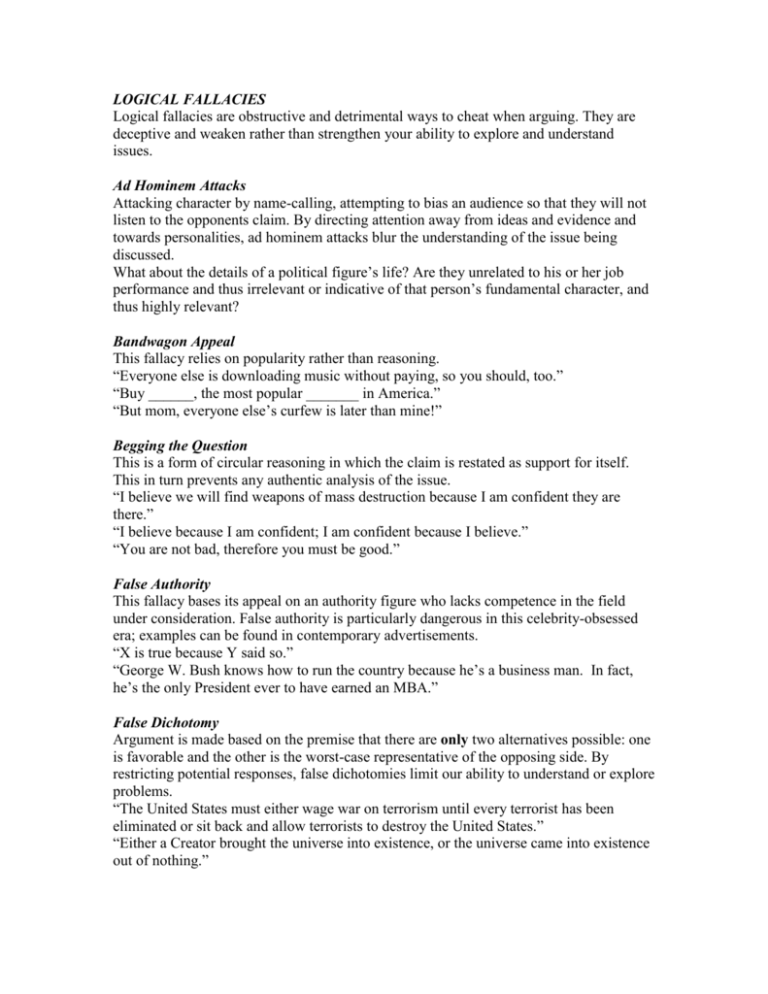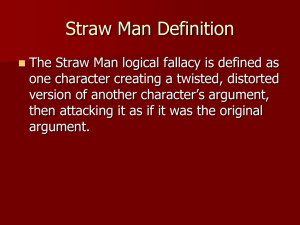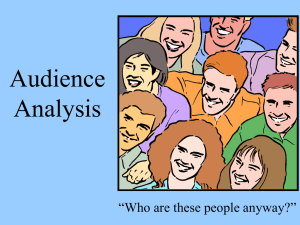Logical Fallacies
advertisement

LOGICAL FALLACIES Logical fallacies are obstructive and detrimental ways to cheat when arguing. They are deceptive and weaken rather than strengthen your ability to explore and understand issues. Ad Hominem Attacks Attacking character by name-calling, attempting to bias an audience so that they will not listen to the opponents claim. By directing attention away from ideas and evidence and towards personalities, ad hominem attacks blur the understanding of the issue being discussed. What about the details of a political figure’s life? Are they unrelated to his or her job performance and thus irrelevant or indicative of that person’s fundamental character, and thus highly relevant? Bandwagon Appeal This fallacy relies on popularity rather than reasoning. “Everyone else is downloading music without paying, so you should, too.” “Buy ______, the most popular _______ in America.” “But mom, everyone else’s curfew is later than mine!” Begging the Question This is a form of circular reasoning in which the claim is restated as support for itself. This in turn prevents any authentic analysis of the issue. “I believe we will find weapons of mass destruction because I am confident they are there.” “I believe because I am confident; I am confident because I believe.” “You are not bad, therefore you must be good.” False Authority This fallacy bases its appeal on an authority figure who lacks competence in the field under consideration. False authority is particularly dangerous in this celebrity-obsessed era; examples can be found in contemporary advertisements. “X is true because Y said so.” “George W. Bush knows how to run the country because he’s a business man. In fact, he’s the only President ever to have earned an MBA.” False Dichotomy Argument is made based on the premise that there are only two alternatives possible: one is favorable and the other is the worst-case representative of the opposing side. By restricting potential responses, false dichotomies limit our ability to understand or explore problems. “The United States must either wage war on terrorism until every terrorist has been eliminated or sit back and allow terrorists to destroy the United States.” “Either a Creator brought the universe into existence, or the universe came into existence out of nothing.” Hasty Generalization Hasty Generalizations make a broad claim on the basis of narrow evidence and, sometimes, on the basis of only one or two examples. These generalizations will not have sufficient evidence to make a claim. “While in prison, this man was part of a new program to prepare convicts for life on the outside. The day after he was released from prison, he robbed a gas station at gun point. Obviously, such reform programs are a failure and funding for them should be withdrawn.” “Smith, who is from England, decides to attend graduate school at Ohio State University. He has never been to the US before. The day after he arrives, he is walking back from an orientation session and sees two white (albino) squirrels chasing each other around a tree. In his next letter home, he tells his family that American squirrels are white.” Non Sequitur A non sequitur is distinguished by reasoning or evidence that is exceptionally irrelevant to the claim being made. “Cats are evil because they’re too fast.” By extension of this logic, anything fast would also be evil. “If you buy this cell phone, everyone will love you.” Obviously, people loving you is unrelated to your cell phone. Advertising uses nonsequiturs to appeal to emotions. “Your family will be safe in this car,” “If you don’t buy this dog food, you are neglecting your dog.” Oversimplification This happens when complex causal relationships are reduced or ignored in favor of a simple claim that fails to address significant dimensions of an issue. “The only way to end crime is to eliminate poverty.” Poverty is only one of the many factors that influence crime, and not all poor individuals commit crime. Post Hoc, Ergo Propter Hoc “After this, therefore because of this.” This “post hoc” fallacy confuses chronology with causation, asserting that because one event happened after another, is must have been caused by the earlier event. Without explanation for the event and by ignoring the fact that the event could have happened for a different reason, it discourages us from carefully examining the overall situation. “After president Bush was elected, the economy took a dive. Therefore, Bush must be responsible for the recession.” “I had been doing pretty poorly this season. Then my girlfriend gave me this neon laces for my spikes and I won my next three races. Those laces must be good luck...if I keep on wearing them I can't help but win!” Red Herring Introducing an irrelevant but sensational issue in order to divert the argument from its proper focus. Such diversions make it very difficult to advance understanding of the real issue. It also weakens the organization of the argument by moving away from the topic at hand. Topic A is discussed. Topic B is introduced under the guise of being relevant to topic A (when topic B is actually not relevant to topic A). Topic A is abandoned. Miss Teen South Carolina! http://www.youtube.com/watch?v=lj3iNxZ8Dww Miss Teen South Carolina misunderstood the question, and/or did not come up with an answer in time and chose to address a similar but different issue. Ultimately, she did great at distracting everyone from the original topic but failed at being taken seriously. Slippery Slope This is a very common type of fallacy in debates on contentious social issues. The fallacy implies that a small step in a certain direction, in personal choice or social policy, will inevitably lead one down a slippery slope towards ruin and disaster. This strategy ignores the explanatory steps toward the consequence. It essentially becomes a prediction, rather than an argument. “If reality television is not prohibited, it will cause viewers to lose all ability to distinguish between the real and unreal, and this will ultimately result in their not being able to think at all.” Stirring Symbols/Flag Waving This fallacy uses powerful symbols to appeal to our emotions instead of our reason (it is often on display during election years). These appeals have nothing to do with evidence that we should vote for them, but instead try to persuade us with moving cultural symbols. Photo opportunities: A candidate appearing on TV with an American farmer, a school teacher, children, bowling with the “common” man, etc. Straw-man Argument (Straw-Person Argument) This is an invalid form of counterargument. One sets up an exaggerated, simplified, or possibly falsified version of the opposing position and then “refutes” it with claims that ignore the opponent’s actual reasoning. “Winning” a straw-person argument gives the illusion of argumentative competence, but the tactics don’t contribute to our understanding of the problem. In many instances, the person committing the straw man fallacy highlights the most extreme position of the opposing side—for example: Opposing argument: Teens should be taught about contraception methods so that they can practice safe sex should they choose to have intercourse. Straw man argument: Proponents of sex education want to give kids license to have sex with no consequences. This straw man argument ignores the things that make the issue of sex education complicated, and it boils down the opposing position to a narrow, extreme view. In other cases, speakers commit the straw man fallacy by highlighting the actions of a minority of the opposing side—for example: Opposing argument: Bicycle infrastructure should be expanded because cycling is a sustainable mode of transportation. Straw man argument: We should not build bike lanes because cyclists run red lights and endanger pedestrians. Here, the straw man argument ignores the positive aspects of bicycle infrastructure and focuses on the minority of cyclists who don’t follow traffic rules. And some straw man arguments oversimplify the opposing viewpoint so that it is easy to refute—for example: Opposing argument: Publicly funded healthcare should be enacted in the U.S. so that all Americans can have equal access to the care they need to live full, happy, and productive lives. Straw man argument: In this age of government spending run amok, the last thing we need is another entitlement. This argument ignores the complex issues surrounding publicly funded healthcare and resorts to generic rhetoric that pushes buttons but provides little substance.






